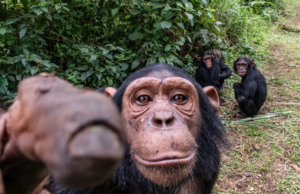Ivory Coast, Africa: Defenders of the Great Apes

Through his reports, photos and videos, we will be able to penetrate in this beautiful African forest, which together with the rest of Africa and the living beings who still survive is threatened to extinction.
When we show to the world a piece of Africa, we alert about the need to implement efective projects to protect that priviliged nature and resources, which are sacred patrimony of planet Earth.
My name’s Serge K. Soiret and I am preparing a doctorate in tropical ecology at the department of biological sciences at the University of Cocody, Abidjan (capital of Ivory Coast) on the theme “Variation in nut-cracking by chimpanzees in Taï National Park: ecological variation or culture?” Located in the South-West of Ivory Coast, near the border of Liberia, TaïNational Park is the largest primary tropical forest under protection.
Preliminary observations carried out in this park revealed a difference in the choice of nuts to crack between two communities of savage chimpanzees Pan troglodytes verus in the same forest block in Taï (1) and Djouroutou (2), distant of surroundings 60 km. It was noticed that the groups of chimpanzees of Taï prefer to crack nuts of Coula edulis, Parinari excelsa and Panda oleosa, whereas those of Djouroutou prefer in addition to other nuts crackingSacoglottis gabonensis(3), the latter being seldom cracked in Taï.
The objective of this study is to highlight this important difference in the behavior of nut cracking between the two genetically close communities; Then, to identify the ecological and/or cultural factors if required. Each month, I leave Abidjan for the TaïNational Park, which is 1050 km away from the city.
On the spot, I go with my friends to the forest to observe the chimpanzees. Each return to the forest requires a program to know what we must do during 10 or 20 days and the huts are arranged for a pleasant stay.
Our observations doors on the Botanicaland Faunal statements include phenological study and estimative of availability of the fruit-bearing resources for the wild chimpanzees throughout our work on the territory. We raise the trees whose nuts are consumed by the chimpanzees and measure the diameter with height of chest DBH (Diameter Breast Height) equal to or higher than 10 cm on each side of the tracks identified and chosen. We observe the chimpanzees from time to time, since they are not very accustomed yet. Only 5 male let ourselves approach about 5 meters and the very apprehensive females are the most numerous of the group.
According to the observations and the activities carried out, the chimpanzees of the territory of Djouroutou should no be estimated as one score of individuals. This number is not checked, because there must have a true study to identify the precise number.
The chimpanzees are followed during their daily displacements. The data relating to the nut-crackingof Sacoglottis gabonensis are collected. We also characterize the tools used by the chimpanzees to crack their nuts: the weight and the nature of the hammers (stones or wood), the nature of the anvils (stones or wood) and their position.
(1) The North-Western part of the Park (the Taï sector) in the valley Audrenisrou.
(2) The southern part of the Park (the Djouroutou sector) in the south of the river Hana, area where I’m based.
(3) Nut present at Taï and Djouroutou but strongly cracked in Djouroutou.

 Español
Español
 Português
Português








